Predicting the Effect of Fly Ash on Concrete’s Mechanical Properties by ANN
Abstract
1. Introduction
2. Artificial Neural Network
- 1-
- processing of information occurs in simple members called neurons;
- 2-
- signals are passed to neurons over connection links;
- 3-
- every connection has an associated weight;
- 4-
- each neuron transmits inputs from the activation function and determines outputs.
2.1. Dataset
2.2. Network Modeling
Network Performance
3. Results and Discussion
3.1. Stability Analysis
3.2. Sensitivity Analysis
3.3. Validation of ANN Model
3.4. Development of Empirical Approach to Determine Concrete Compressive Strength
4. Conclusions
Author Contributions
Funding
Data Availability Statement
Conflicts of Interest
References
- Bramley, G.; Power, S. Urban form and social sustainability: The role of density and housing type. Environ. Plan. B Plan. Des. 2009, 36, 30–48. [Google Scholar] [CrossRef]
- Cement and Concrete Institute. Sustainable Concrete. 2011. Available online: http://www.cnci.org.za (accessed on 12 January 2021).
- Samad, S.; Shah, A. Role of binary cement including Supplementary Cementitious Material (SCM), in production of environmentally sustainable concrete: A critical review. Int. J. Sustain. Built Environ. 2017, 6, 663–674. [Google Scholar] [CrossRef]
- Abbas, S.; Arshad, U.; Abbass, W.; Nehdi, M.L.; Ahmed, A. Recycling Untreated Coal Bottom Ash with Added Value for Mitigating Alkali–Silica Reaction in Concrete: A Sustainable Approach. Sustainability 2020, 12, 10631. [Google Scholar] [CrossRef]
- Morla, P.; Gupta, R.; Azarsa, P.; Sharma, A. Corrosion Evaluation of Geopolymer Concrete Made with Fly Ash and Bottom Ash. Sustainability 2021, 13, 398. [Google Scholar] [CrossRef]
- Clear, C.; Higgins, D.; Lindon, S. Embodied CO2 of UK Cement, Additions and Cementitious Material, Factsheet 18 (P1); British Cement Association (BCA): Camberley, UK, 2009. [Google Scholar]
- Chen, C.; Habert, G.; Bouzidi, Y.; Jullien, A. Environmental impact of cement production: Detail of the different processes and cement plant variability evaluation. J. Clean. Prod. 2010, 18, 478–485. [Google Scholar] [CrossRef]
- Aponte, D.F.; Barra, M.; Vàzquez, E. Durability and cementing efficiency of fly ash in concretes. Constr. Build. Mater. 2012, 30, 537–546. [Google Scholar] [CrossRef]
- Badogiannis, E.; Papadakis, V.; Chaniotakis, E.; Tsivilis, S. Exploitation of poor Greek kaolins: Strength development of metakaolin concrete and evaluation by means of k-value. Cem. Concr. Res. 2004, 34, 1035–1041. [Google Scholar] [CrossRef]
- Pekmezci, B.; Akyüz, S. Optimum usage of a natural pozzolan for the maximum compressive strength of concrete. Cem. Concr. Res. 2004, 34, 2175–2179. [Google Scholar] [CrossRef]
- Farhangi, V.; Karakouzian, M. Effect of fiber reinforced polymer tubes filled with recycled materials and concrete on structural capacity of pile foundations. Appl. Sci. 2020, 10, 1554. [Google Scholar] [CrossRef]
- Malvar, L.J.; Lenke, L.R. Efficiency of fly ash in mitigating alkali-silica reaction based on chemical composition. ACI Mater. J. 2006, 103, 319. [Google Scholar]
- Shaikh, F.U.A.; Supit, S.W. Chloride induced corrosion durability of high volume fly ash concretes containing nano particles. Constr. Build. Mater. 2015, 99, 208–225. [Google Scholar] [CrossRef]
- Shaikh, F.U.; Supit, S.W. Mechanical and durability properties of high volume fly ash (HVFA) concrete containing calcium carbonate (CaCO3) nanoparticles. Constr. Build. Mater. 2014, 70, 309–321. [Google Scholar] [CrossRef]
- Farhangi, V.; Karakouzian, M. Design of Bridge Foundations Using Reinforced Micropiles. In Proceedings of the International Road Federation Global R2T Conference & Expo, Las Vegas, NV, USA, 19–22 November 2019; pp. 19–22. [Google Scholar]
- Hemalatha, T.; Ramaswamy, A. A review on fly ash characteristics—Towards promoting high volume utilization in developing sustainable concrete. J. Clean. Prod. 2017, 147, 546–559. [Google Scholar] [CrossRef]
- Salimi, J.; Ramezanianpour, A.M.; Moradi, M.J. Studying the effect of low reactivity metakaolin on free and restrained shrinkage of high performance concrete. J. Build. Eng. 2020, 28, 101053. [Google Scholar] [CrossRef]
- Aghayari, R.; Moradi, M. Improving the punching shear strength of RC slabs by FRP and steel sheets. J. Rehabil. Civ. Eng. 2016, 4, 1–17. [Google Scholar]
- Daneshvar, K.; Moradi, M.J.; Amooie, M.; Chen, S.; Mahdavi, G.; Hariri-Ardebili, M.A. Response of low-percentage FRC slabs under impact loading: Experimental, numerical, and soft computing methods. In Structures; Elsevier: Amsterdam, The Netherlands, 2020; Volume 27, pp. 975–988. [Google Scholar]
- Oner, A.; Akyuz, S.; Yildiz, R. An experimental study on strength development of concrete containing fly ash and optimum usage of fly ash in concrete. Cem. Concr. Res. 2005, 35, 1165–1171. [Google Scholar] [CrossRef]
- Abiodun, O.I.; Jantan, A.; Omolara, A.E.; Dada, K.V.; Mohamed, N.A.; Arshad, H. State-of-the-art in artificial neural network applications: A survey. Heliyon 2018, 4, e00938. [Google Scholar] [CrossRef]
- Moradi, M.J.; Roshani, M.M.; Shabani, A.; Kioumarsi, M. Prediction of the Load-Bearing Behavior of SPSW with Rectangular Opening by RBF Network. Appl. Sci. 2020, 10, 1185. [Google Scholar] [CrossRef]
- Haykin, S. Neural Networks: A Comprehensive Foundation; Prentice Hall PTR: Lebanon, IN, USA, 1994. [Google Scholar]
- Werbos, P.J. An overview of neural networks for control. IEEE Control Syst. Mag. 1991, 11, 40–41. [Google Scholar]
- Rumelhart, D.E.; Widrow, B.; Lehr, M.A. The basic ideas in neural networks. Commun. ACM 1994, 37, 87–93. [Google Scholar] [CrossRef]
- Naderpour, H.; Mirrashid, M. An innovative approach for compressive strength estimation of mortars having calcium inosilicate minerals. J. Build. Eng. 2018, 19, 205–215. [Google Scholar] [CrossRef]
- Naderpour, H.; Kheyroddin, A.; Amiri, G.G. Prediction of FRP-confined compressive strength of concrete using artificial neural networks. Compos. Struct. 2010, 92, 2817–2829. [Google Scholar] [CrossRef]
- Roshani, M.; Phan, G.T.; Ali, P.J.M.; Roshani, G.H.; Hanus, R.; Duong, T.; Corniani, E.; Nazemi, E.; Kalmoun, E.M. Evaluation of flow pattern recognition and void fraction measurement in two phase flow independent of oil pipeline’s scale layer thickness. Alex. Eng. J. 2020, 60, 1955–1966. [Google Scholar] [CrossRef]
- Zadeh, E.E.; Feghhi, S.; Roshani, G.; Rezaei, A. Application of artificial neural network in precise prediction of cement elements percentages based on the neutron activation analysis. Eur. Phys. J. Plus 2016, 131, 167. [Google Scholar] [CrossRef]
- Hagan, M.T.; Menhaj, M.B. Training feedforward networks with the Marquardt algorithm. IEEE Trans. Neural Netw. 1994, 5, 989–993. [Google Scholar] [CrossRef]
- Roshani, G.; Feghhi, S.; Mahmoudi-Aznaveh, A.; Nazemi, E.; Adineh-Vand, A. Precise volume fraction prediction in oil–water–gas multiphase flows by means of gamma-ray attenuation and artificial neural networks using one detector. Measurement 2014, 51, 34–41. [Google Scholar] [CrossRef]
- Mahmoudi, M.R.; Heydari, M.H.; Avazzadeh, Z.; Pho, K.H. Goodness of fit test for almost cyclostationary processes. Digit. Signal Process. 2020, 96, 102597. [Google Scholar] [CrossRef]
- Mahmoudi, M.; Mahmoudi, M. Inference on the ratio of variances of two independent populations. J. Math. Ext. 2013, 7, 83–91. [Google Scholar]
- Mahmoudi, M.R.; Maleki, M.; Pak, A. Testing the equality of two independent regression models. Commun. Stat. Theory Methods 2018, 47, 2919–2926. [Google Scholar] [CrossRef]
- Haghbin, H.; Mahmoudi, M.R.; Shishebor, Z. Large sample inference on the ratio of two independent binomial proportions. J. Math. Ext. 2015, 5, 87–95. [Google Scholar]
- Mahmoudi, M.R. On comparing two dependent linear and nonlinear regression models. J. Test. Eval. 2018, 47, 449–458. [Google Scholar] [CrossRef]
- Feng, D.C.; Liu, Z.T.; Wang, X.D.; Chen, Y.; Chang, J.Q.; Wei, D.F.; Jiang, Z.M. Machine learning-based compressive strength prediction for concrete: An adaptive boosting approach. Constr. Build. Mater. 2020, 230, 117000. [Google Scholar] [CrossRef]
- Chandrasekaran, G.; Periyasamy, S.; Karthikeyan, P. Test scheduling for system on chip using modified firefly and modified ABC algorithms. SN Appl. Sci. 2019, 1, 1079. [Google Scholar] [CrossRef]
- Garson, D.G. Interpreting Neural Network Connection Weights. AI Expert 1991, 6, 47–51. [Google Scholar]
- Goh, A.T. Back-propagation neural networks for modeling complex systems. Artif. Intell. Eng. 1995, 9, 143–151. [Google Scholar] [CrossRef]
- Getahun, M.A.; Shitote, S.M.; Gariy, Z.C.A. Artificial neural network based modelling approach for strength prediction of concrete incorporating agricultural and construction wastes. Constr. Build. Mater. 2018, 190, 517–525. [Google Scholar] [CrossRef]
- Khorsandi, M.; Feghhi, S.; Salehizadeh, A.; Roshani, G. Developing a gamma ray fluid densitometer in petroleum products monitoring applications using Artificial Neural Network. Radiat. Meas. 2013, 59, 183–187. [Google Scholar] [CrossRef]
- Chandrasekaran, G.; Periyasamy, S.; Rajamanickam, K.P. Minimization of test time in system on chip using artificial intelligence-based test scheduling techniques. Neural Comput. Appl. 2020, 32, 5303–5312. [Google Scholar] [CrossRef]
- Blissett, R.; Rowson, N. A review of the multi-component utilisation of coal fly ash. Fuel 2012, 97, 1–23. [Google Scholar] [CrossRef]
- Durdziński, P.T.; Dunant, C.F.; Haha, M.B.; Scrivener, K.L. A new quantification method based on SEM-EDS to assess fly ash composition and study the reaction of its individual components in hydrating cement paste. Cem. Concr. Res. 2015, 73, 111–122. [Google Scholar] [CrossRef]
- Shehata, M.H.; Thomas, M.D. The effect of fly ash composition on the expansion of concrete due to alkali—Silica reaction. Cem. Concr. Res. 2000, 30, 1063–1072. [Google Scholar] [CrossRef]
- Ghanbari, M.; Hadian, A.; Nourbakhsh, A.; MacKenzie, K. Modeling and optimization of compressive strength and bulk density of metakaolin-based geopolymer using central composite design: A numerical and experimental study. Ceram. Int. 2017, 43, 324–335. [Google Scholar] [CrossRef]
- Bendapudi, S.C.K.; Saha, P. Contribution of fly ash to the properties of mortar and concrete. Int. J. Earth Sci. Eng. 2011, 4, 1017–1023. [Google Scholar]
- Saha, A.K. Effect of class F fly ash on the durability properties of concrete. Sustain. Environ. Res. 2018, 28, 25–31. [Google Scholar] [CrossRef]
- Topcu, I.B.; Canbaz, M. Effect of different fibers on the mechanical properties of concrete containing fly ash. Constr. Build. Mater. 2007, 21, 1486–1491. [Google Scholar] [CrossRef]
- Haque, M.; Kayali, O. Properties of high-strength concrete using a fine fly ash. Cem. Concr. Res. 1998, 28, 1445–1452. [Google Scholar] [CrossRef]
- Berry, E.; Hemmings, R.; Cornelius, B. Mechanisms of hydration reactions in high volume fly ash pastes and mortars. Cem. Concr. Compos. 1990, 12, 253–261. [Google Scholar] [CrossRef]
- Berry, E.E.; Hemmings, R.T.; Zhang, M.H.; Cornelius, B.J.; Golden, D.M. Hydration in high-volume fly ash concrete binders. Mater. J. 1994, 91, 382–389. [Google Scholar]
- Feldman, R.; Carette, G.; Malhotra, V. Studies on mechanics of development of physical and mechanical properties of high-volume fly ash-cement pastes. Cem. Concr. Compos. 1990, 12, 245–251. [Google Scholar] [CrossRef]
- ACI Committee. Building Code Requirements for Structural Concrete (ACI 318-08) and Commentary; American Concrete Institute: Farmington Hills, MI, USA, 2008. [Google Scholar]
- British Standards Institution. Structural Use of Concrete, Part 1—Code of Practice for Design and Construction; BS8110, B; British Standards Institution: London, UK, 1997. [Google Scholar]
- Leung, C.K.; Ng, M.Y.; Luk, H.C. Empirical approach for determining ultimate FRP strain in FRP-strengthened concrete beams. J. Compos. Constr. 2006, 10, 125–138. [Google Scholar] [CrossRef]

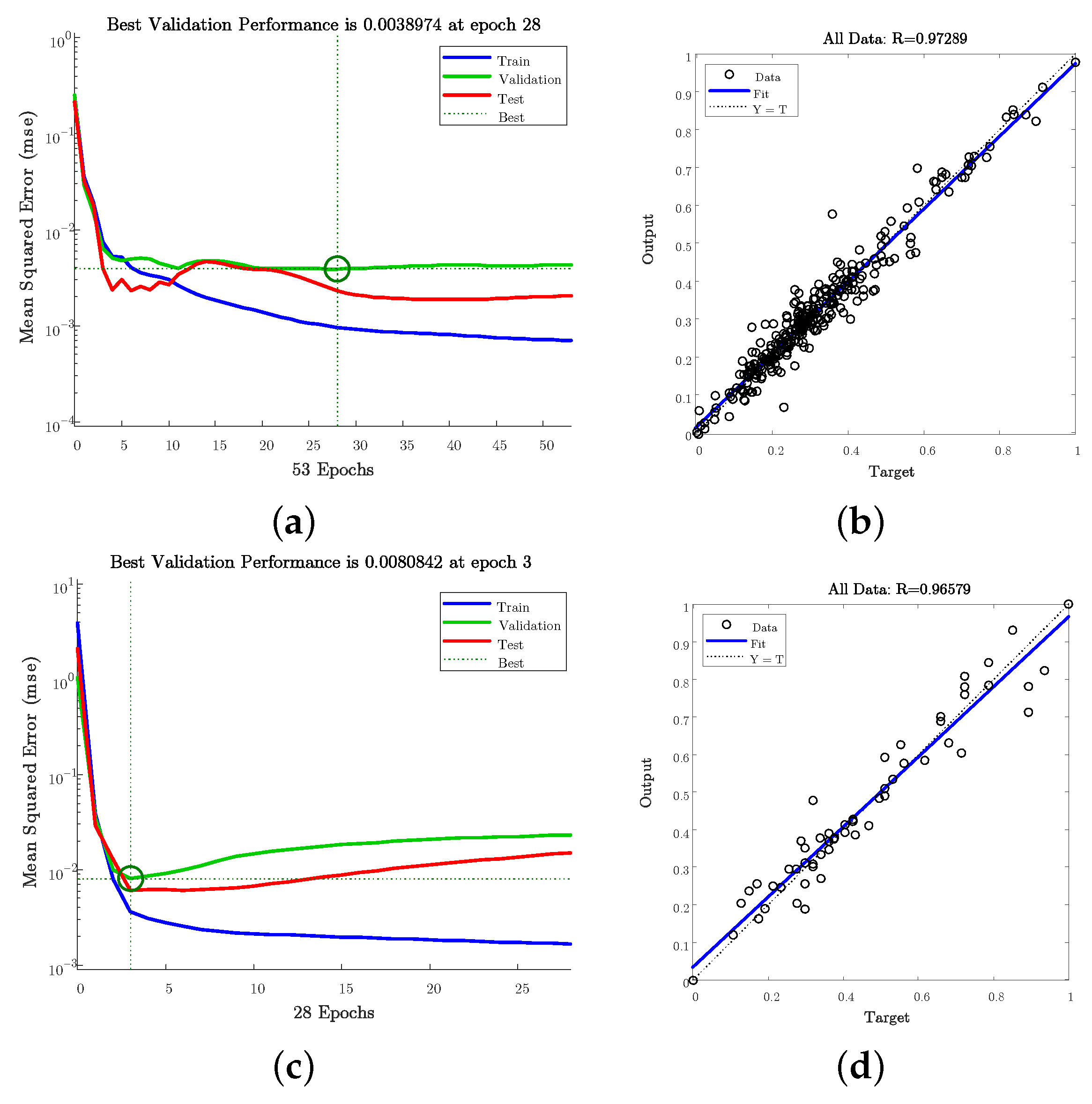
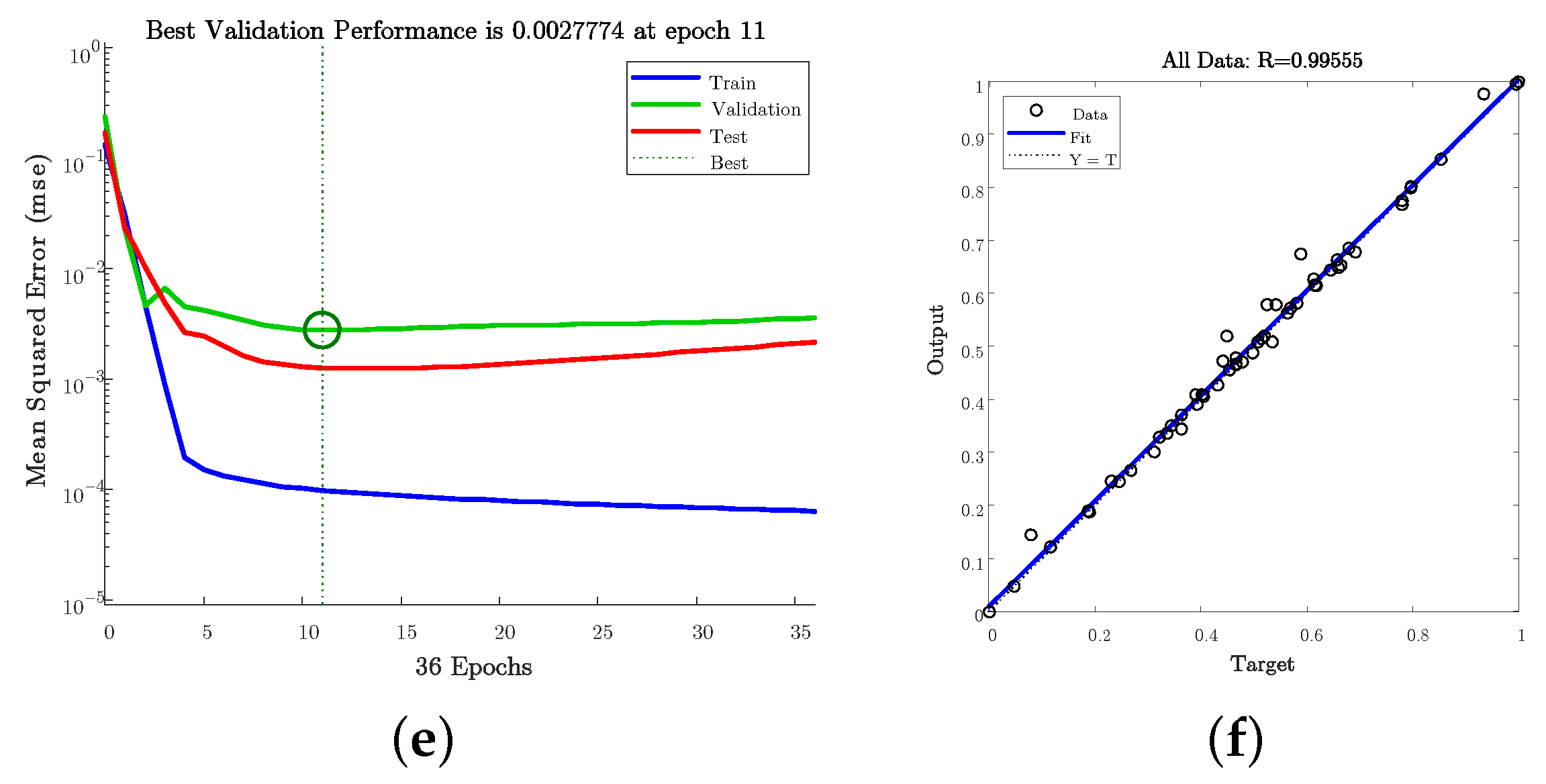
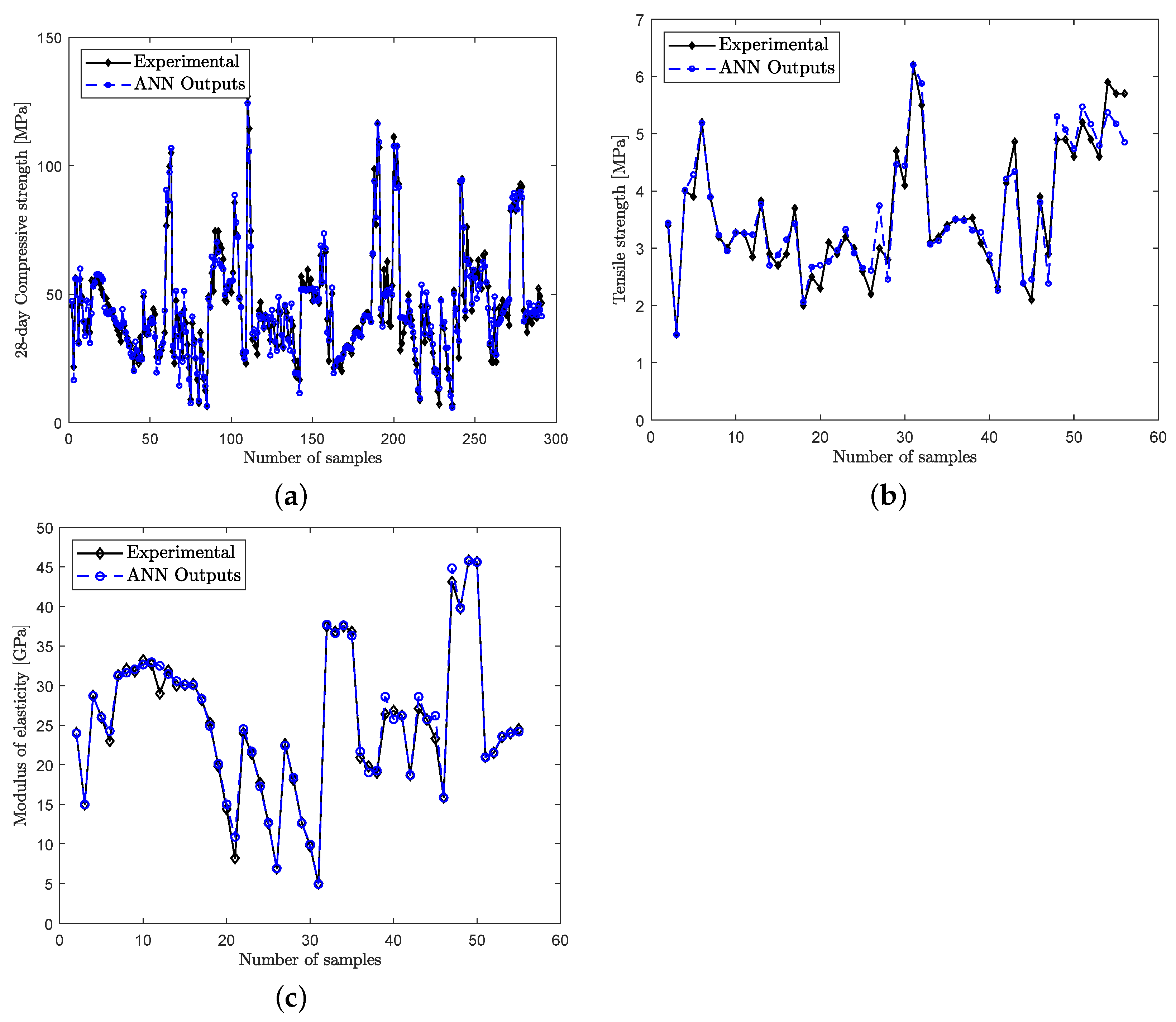
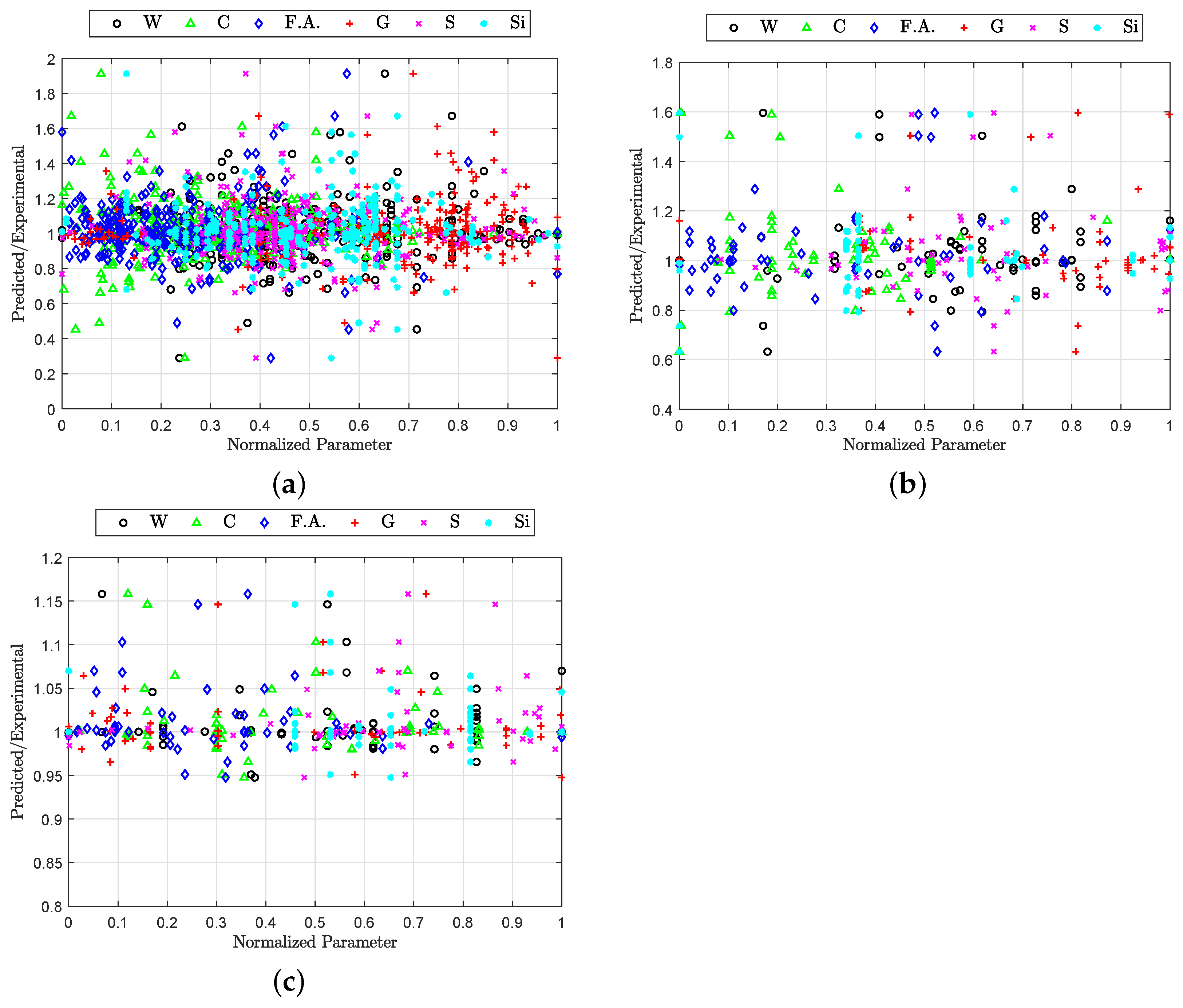
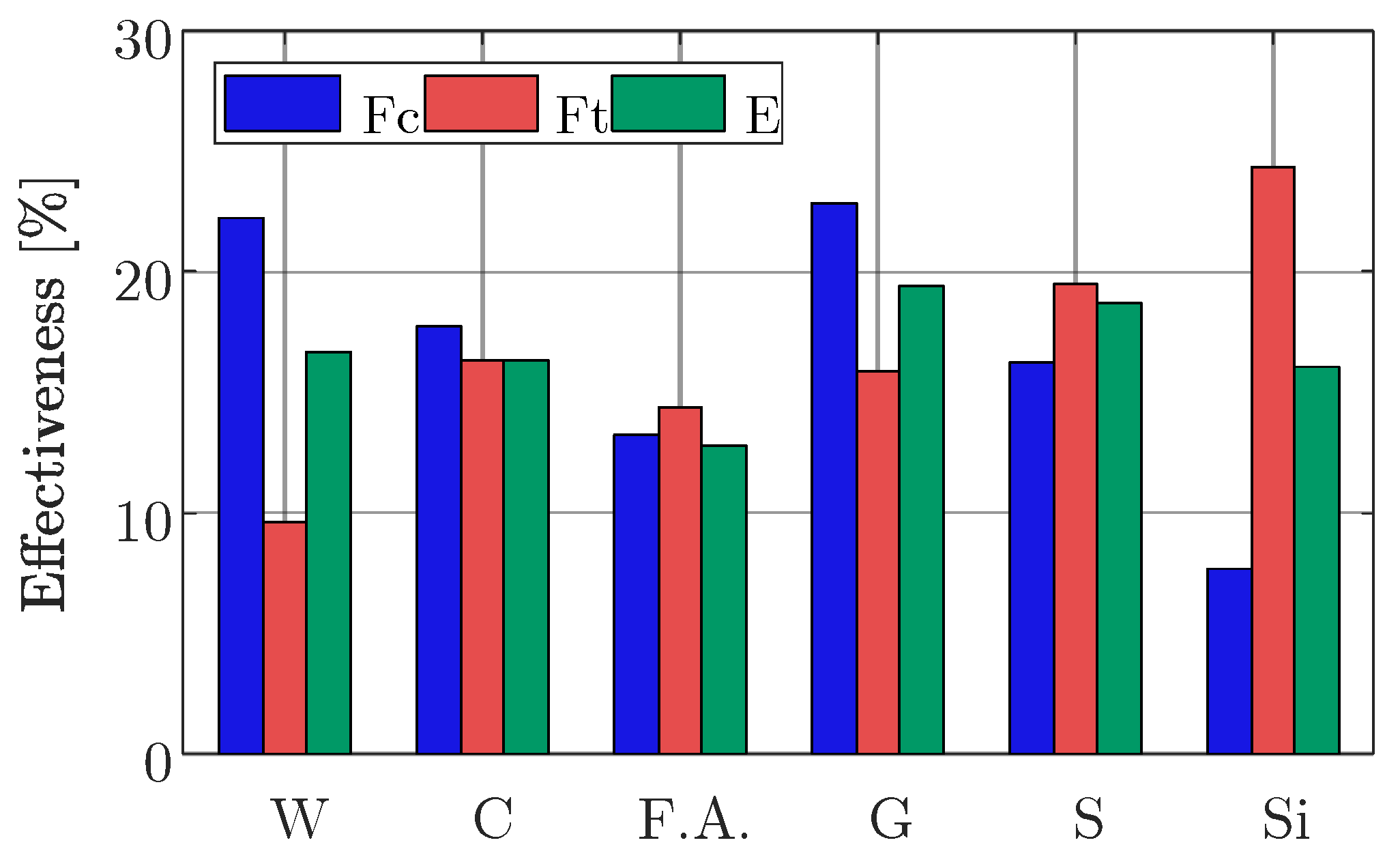
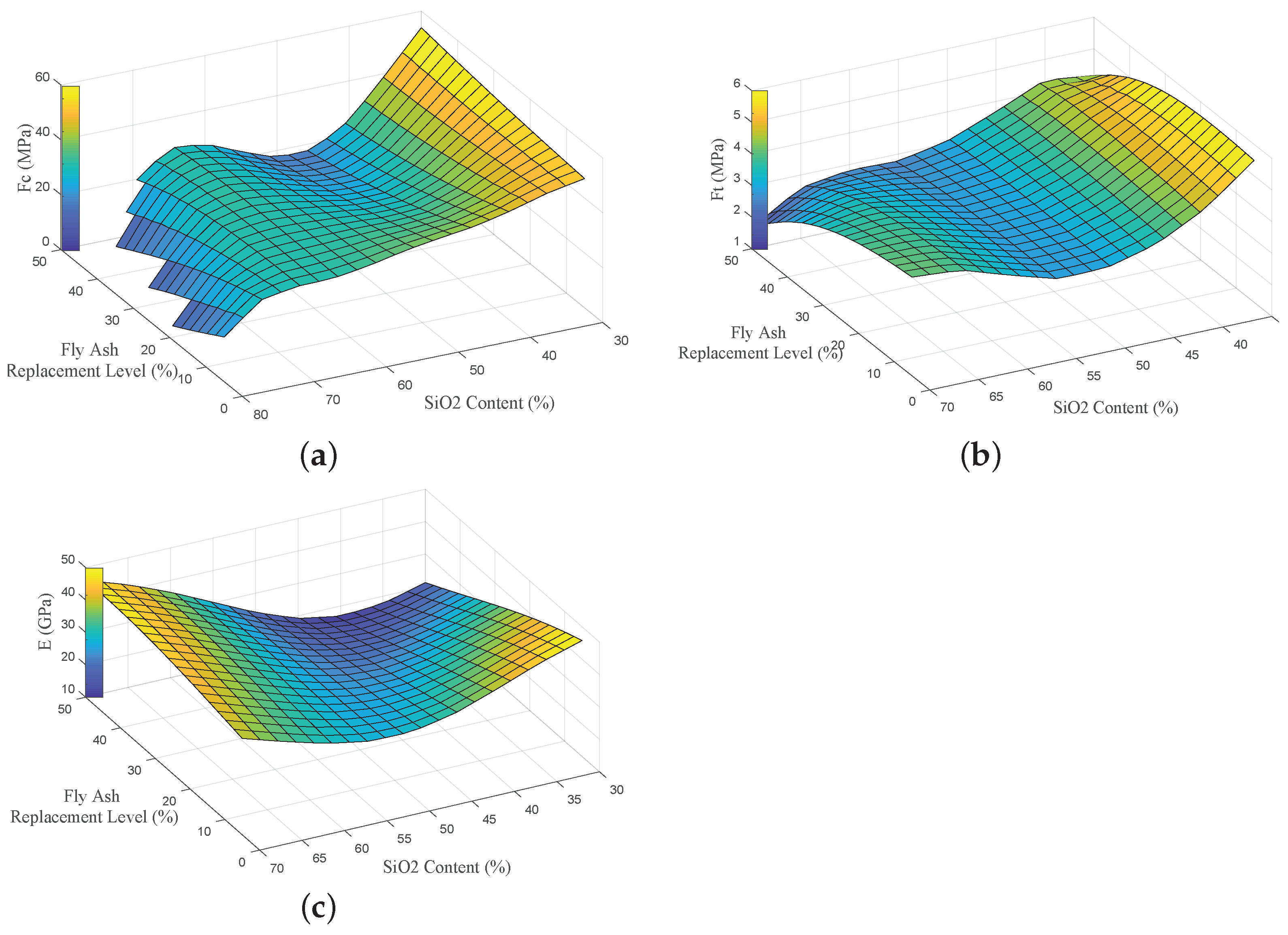
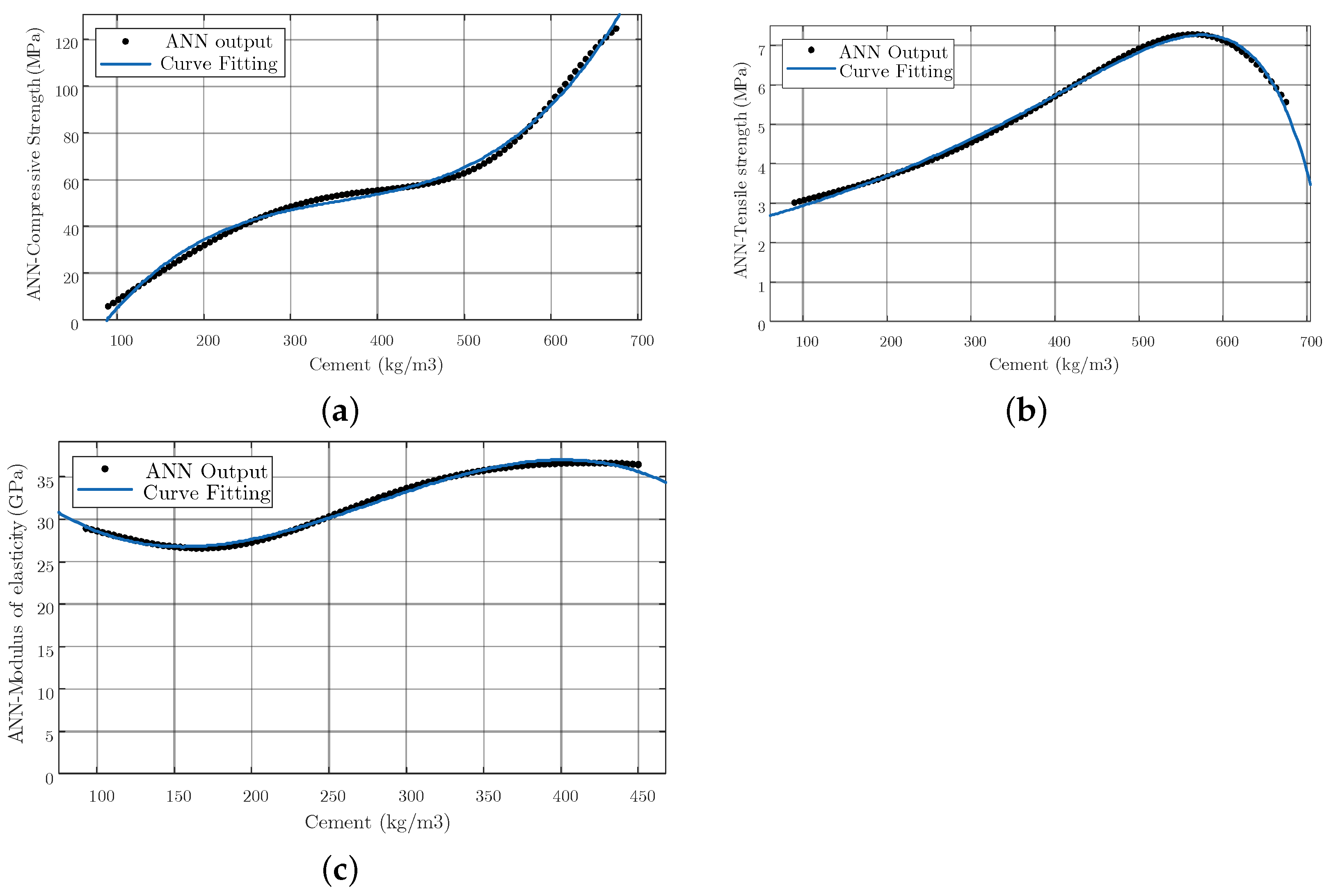

| Attribute | Unit | Min | Max | Average | Standard Deviation |
|---|---|---|---|---|---|
| Water | kg/m3 | 100 | 255 | 173.25 | 30.35 |
| Cement | kg/m3 | 90 | 675 | 273.9 | 100.44 |
| Fly ash | kg/m3 | 10 | 544 | 139.04 | 87.1 |
| Coarse Aggregate | kg/m3 | 436 | 1278 | 976.83 | 195.03 |
| Fine Aggregate | kg/m3 | 279 | 1293 | 749.27 | 178.25 |
| SiO2 | % | 26.61 | 79.34 | 52.63 | 9.31 |
| 28-day compressive strength | MPa | 5 | 121 | 41.35 | 20.64 |
| Tensile strength | MPa | 1.5 | 6.2 | 3.62 | 1.09 |
| Modulus of elasticity | GPa | 5 | 45.8 | 25.28 | 9.13 |
| Target Response | Network Performance | |||||
|---|---|---|---|---|---|---|
| MSE | RMSE | MAE | MAPE | NSE | R | |
| 28-day compressive strength | 0.0016 | 0.0401 | 0.028 | 14.89 | 0.9639 | 0.9729 |
| Tensile strength | 0.0036 | 0.0602 | 0.0436 | 11.87 | 0.9324 | 0.9658 |
| Modulus of elasticity | 0.0004 | 0.0221 | 0.0119 | 3.78 | 0.9902 | 0.9955 |
| Mixture | Cement | Water | Coarse Aggregate | Fine Aggregate | Fly Ash |
|---|---|---|---|---|---|
| C30 | 370 | 185 | 1232 | 698 | 18.5–185 |
| Target Response | Curve Fitting Equation | MSE |
|---|---|---|
| 28-day compressive strength | 0.0002 | |
| Tensile strength | 0.0055 | |
| Modulus of elasticity | 0.088 |
| Correction Function | Compressive Strength | Tensile Strength | Modulus of Elasticity |
|---|---|---|---|
| Cw | |||
| CF.A. | |||
| CG | |||
| CS | |||
| Csi |
| Mechanical Properties | Approach | MSE | R | No. of Data in Error Range and Percentage to Total Data | ||
|---|---|---|---|---|---|---|
| Compressive strength | ANN Analysis | 0.0016 | 0.9729 | 242 (83.16%) | 275 (94.5%) | 283 (97.25%) |
| Empirical | 0.025 | 0.6358 | 100 (34.36%) | 189 (64.94%) | 245 (84.19%) | |
| Tensile strength | ANN Analysis | 0.0036 | 0.9658 | 47 (83.92%) | 52 (92.85%) | 56 (100%) |
| Empirical | 0.224 | 0.585 | 4 (7.14%) | 18 (32.14%) | 36 (64.28%) | |
| Modulus of elasticity | ANN Analysis | 0.0004 | 0.9955 | 54 (98.18%) | 55 (100%) | 55 (100%) |
| Empirical | 0.083 | 0.6196 | 8 (14.54%) | 16 (29.1%) | 44 (80%) | |
Publisher’s Note: MDPI stays neutral with regard to jurisdictional claims in published maps and institutional affiliations. |
© 2021 by the authors. Licensee MDPI, Basel, Switzerland. This article is an open access article distributed under the terms and conditions of the Creative Commons Attribution (CC BY) license (http://creativecommons.org/licenses/by/4.0/).
Share and Cite
Roshani, M.M.; Kargar, S.H.; Farhangi, V.; Karakouzian, M. Predicting the Effect of Fly Ash on Concrete’s Mechanical Properties by ANN. Sustainability 2021, 13, 1469. https://doi.org/10.3390/su13031469
Roshani MM, Kargar SH, Farhangi V, Karakouzian M. Predicting the Effect of Fly Ash on Concrete’s Mechanical Properties by ANN. Sustainability. 2021; 13(3):1469. https://doi.org/10.3390/su13031469
Chicago/Turabian StyleRoshani, Mohammad Mehdi, Seyed Hamidreza Kargar, Visar Farhangi, and Moses Karakouzian. 2021. "Predicting the Effect of Fly Ash on Concrete’s Mechanical Properties by ANN" Sustainability 13, no. 3: 1469. https://doi.org/10.3390/su13031469
APA StyleRoshani, M. M., Kargar, S. H., Farhangi, V., & Karakouzian, M. (2021). Predicting the Effect of Fly Ash on Concrete’s Mechanical Properties by ANN. Sustainability, 13(3), 1469. https://doi.org/10.3390/su13031469







